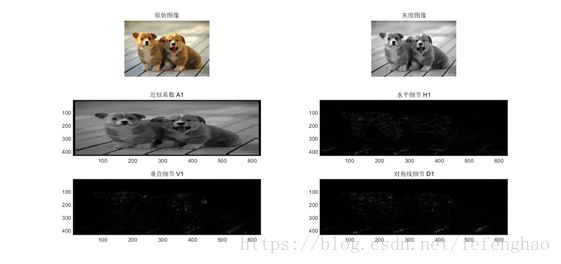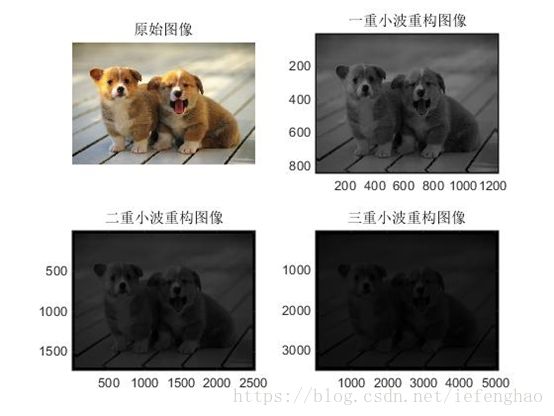数字图像处理--小波变换MATLAB程序
小波变换(wavelet transform,WT)是一种新的变换分析方法,它继承和发展了短时傅立叶变换局部化的思想,同时又克服了窗口大小不随频率变化等缺点,能够提供一个随频率改变的“时间-频率”窗口,是进行信号时频分析和处理的理想工具。它的主要特点是通过变换能够充分突出问题某些方面的特征,能对时间(空间)频率的局部化分析,通过伸缩平移运算对信号(函数)逐步进行多尺度细化,最终达到高频处时间细分,低频处频率细分,能自动适应时频信号分析的要求,从而可聚焦到信号的任意细节,解决了Fourier变换的困难问题,成为继Fourier变换以来在科学方法上的重大突破。(摘自百度百科)
1 小波变换MATLAB程序
//小波变换
I=imread('66.jpg');
subplot(2,2,1);
imshow(I);
title('原始图像');
J=rgb2gray(I);
subplot(3,2,2);
imshow(J);
colormap(map);
title('灰度图像');
[cA1,cH1,cV1,cD1] = dwt2(J,'bior3.7');
A1 = upcoef2('a',cA1,'bior3.7',1);
H1 = upcoef2('h',cH1,'bior3.7',1);
V1 = upcoef2('v',cV1,'bior3.7',1);
D1 = upcoef2('d',cD1,'bior3.7',1);
subplot(3,2,3); image(wcodemat(A1,192));
title('近似系数 A1')
subplot(3,2,4); image(wcodemat(H1,192));
title('水平细节 H1')
subplot(3,2,5); image(wcodemat(V1,192));
title('垂直细节 V1')
subplot(3,2,6); image(wcodemat(D1,192));
title('对角线细节 D1')
Y1=idwt2(A1,H1,V1,D1,'bior3.7');
subplot(2,2,2);image(Y1);title('一重小波重构图像');
处理之后的图像
2 多重小波变换MATLAB程序
//多重小波变换
I=imread('66.jpg');
subplot(2,2,1);
imshow(I);
title('原始图像');
J=rgb2gray(I);
[cA1,cH1,cV1,cD1] = dwt2(J,'bior3.7');
A1 = upcoef2('a',cA1,'bior3.7',1);
H1 = upcoef2('h',cH1,'bior3.7',1);
V1 = upcoef2('v',cV1,'bior3.7',1);
D1 = upcoef2('d',cD1,'bior3.7',1);
Y=idwt2(A1,H1,V1,D1,'bior3.7');
subplot(2,2,2);image(Y);title('一重小波重构图像');
A1 = upcoef2('a',cA1,'bior3.7',2);
H1 = upcoef2('h',cH1,'bior3.7',2);
V1 = upcoef2('v',cV1,'bior3.7',2);
D1 = upcoef2('d',cD1,'bior3.7',2);
Y=idwt2(A1,H1,V1,D1,'bior3.7');
subplot(2,2,3);image(Y);title('二重小波重构图像');
A1 = upcoef2('a',cA1,'bior3.7',3);
H1 = upcoef2('h',cH1,'bior3.7',3);
V1 = upcoef2('v',cV1,'bior3.7',3);
D1 = upcoef2('d',cD1,'bior3.7',3);
Y=idwt2(A1,H1,V1,D1,'bior3.7');
subplot(2,2,4);image(Y);title('三重小波重构图像');
实验结果
下一篇数字图像处理--图像的增强

